
- 6:00am
- 6:15am
- 6:30am
- 6:45am
- 7:00am
- 7:15am
- 7:30am
- 7:45am
- 8:00am
- 8:15am
- 8:30am
- 8:45am
- 9:00am
- 9:15am
- 9:30am
- 9:45am
- 10:00am
- 10:15am
- 10:30am
- 10:45am
- 11:00am
- 11:15am
- 11:30am
- 11:45am
- 12:00pm
- 12:15pm
- 12:30pm
- 12:45pm
- 1:00pm
- 1:15pm
- 1:30pm
- 1:45pm
- 2:00pm
- 2:15pm
- 2:30pm
- 2:45pm
- 3:00pm
- 3:15pm
- 3:30pm
- 3:45pm
- 4:00pm
- 4:15pm
- 4:30pm
- 4:45pm
- 5:00pm
- 5:15pm
- 5:30pm
- 5:45pm
- 6:00pm
- 6:15pm
- 6:30pm
- 6:45pm
- 7:00pm
- 7:15pm
- 7:30pm
- 7:45pm
- 8:00pm
- 8:15pm
- 8:30pm
- 8:45pm
- 9:00pm
- 9:15pm
- 9:30pm
- 9:45pm
- 10:00pm
- 10:15pm
- 10:30pm
- 10:45pm
- 11:00pm
- 11:15pm
- 11:30pm
- 11:45pm
Eat BREAKFAST

- 6:00am
- 6:15am
- 6:30am
- 6:45am
- 7:00am
- 7:15am
- 7:30am
- 7:45am
- 8:00am
- 8:15am
- 8:30am
- 8:45am
- 9:00am
- 9:15am
- 9:30am
- 9:45am
- 10:00am
- 10:15am
- 10:30am
- 10:45am
- 11:00am
- 11:15am
- 11:30am
- 11:45am
- 12:00pm
- 12:15pm
- 12:30pm
- 12:45pm
- 1:00pm
- 1:15pm
- 1:30pm
- 1:45pm
- 2:00pm
- 2:15pm
- 2:30pm
- 2:45pm
- 3:00pm
- 3:15pm
- 3:30pm
- 3:45pm
- 4:00pm
- 4:15pm
- 4:30pm
- 4:45pm
- 5:00pm
- 5:15pm
- 5:30pm
- 5:45pm
- 6:00pm
- 6:15pm
- 6:30pm
- 6:45pm
- 7:00pm
- 7:15pm
- 7:30pm
- 7:45pm
- 8:00pm
- 8:15pm
- 8:30pm
- 8:45pm
- 9:00pm
- 9:15pm
- 9:30pm
- 9:45pm
- 10:00pm
- 10:15pm
- 10:30pm
- 10:45pm
- 11:00pm
- 11:15pm
- 11:30pm
- 11:45pm
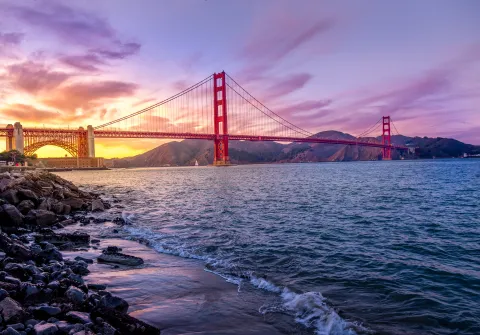
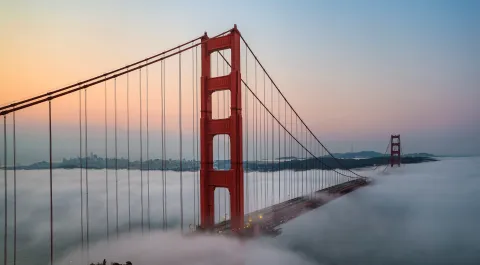
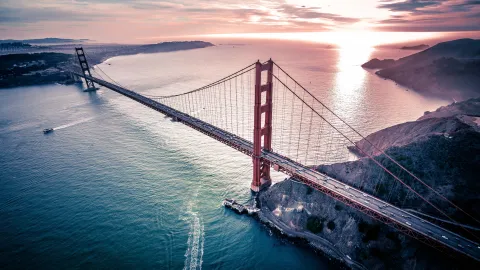
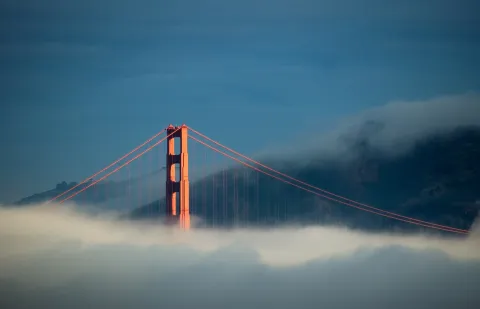
 1.0-2.0 hr stay
1.0-2.0 hr stay
Golden Gate Bridge (Free Entry)
Golden Gate Bridge, san francisco
The Golden Gate Bridge opened in 1937 and is the 1.7-mile-long iconic, most famous, a beautiful bridge connecting San Francisco to Marin County. The bridge is one of the world's Seven Wonders and the most photographed. The bridge is a symbol of American ingenuity and resolve, having been constructed during the era of the Great Depression. Today, this beloved international icon and true engineering marvel carries about 40 million vehicles a year and serves as a vital transportation link and a major travel destination for millions of visitors from around the world.

- 6:00am
- 6:15am
- 6:30am
- 6:45am
- 7:00am
- 7:15am
- 7:30am
- 7:45am
- 8:00am
- 8:15am
- 8:30am
- 8:45am
- 9:00am
- 9:15am
- 9:30am
- 9:45am
- 10:00am
- 10:15am
- 10:30am
- 10:45am
- 11:00am
- 11:15am
- 11:30am
- 11:45am
- 12:00pm
- 12:15pm
- 12:30pm
- 12:45pm
- 1:00pm
- 1:15pm
- 1:30pm
- 1:45pm
- 2:00pm
- 2:15pm
- 2:30pm
- 2:45pm
- 3:00pm
- 3:15pm
- 3:30pm
- 3:45pm
- 4:00pm
- 4:15pm
- 4:30pm
- 4:45pm
- 5:00pm
- 5:15pm
- 5:30pm
- 5:45pm
- 6:00pm
- 6:15pm
- 6:30pm
- 6:45pm
- 7:00pm
- 7:15pm
- 7:30pm
- 7:45pm
- 8:00pm
- 8:15pm
- 8:30pm
- 8:45pm
- 9:00pm
- 9:15pm
- 9:30pm
- 9:45pm
- 10:00pm
- 10:15pm
- 10:30pm
- 10:45pm
- 11:00pm
- 11:15pm
- 11:30pm
- 11:45pm
Eat LUNCH

- 6:00am
- 6:15am
- 6:30am
- 6:45am
- 7:00am
- 7:15am
- 7:30am
- 7:45am
- 8:00am
- 8:15am
- 8:30am
- 8:45am
- 9:00am
- 9:15am
- 9:30am
- 9:45am
- 10:00am
- 10:15am
- 10:30am
- 10:45am
- 11:00am
- 11:15am
- 11:30am
- 11:45am
- 12:00pm
- 12:15pm
- 12:30pm
- 12:45pm
- 1:00pm
- 1:15pm
- 1:30pm
- 1:45pm
- 2:00pm
- 2:15pm
- 2:30pm
- 2:45pm
- 3:00pm
- 3:15pm
- 3:30pm
- 3:45pm
- 4:00pm
- 4:15pm
- 4:30pm
- 4:45pm
- 5:00pm
- 5:15pm
- 5:30pm
- 5:45pm
- 6:00pm
- 6:15pm
- 6:30pm
- 6:45pm
- 7:00pm
- 7:15pm
- 7:30pm
- 7:45pm
- 8:00pm
- 8:15pm
- 8:30pm
- 8:45pm
- 9:00pm
- 9:15pm
- 9:30pm
- 9:45pm
- 10:00pm
- 10:15pm
- 10:30pm
- 10:45pm
- 11:00pm
- 11:15pm
- 11:30pm
- 11:45pm
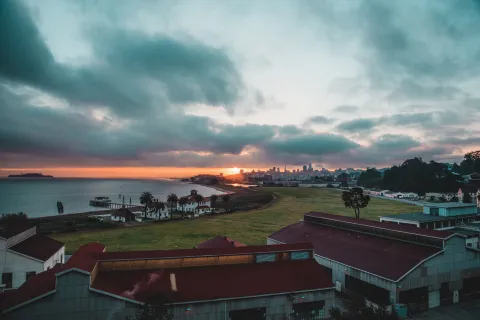
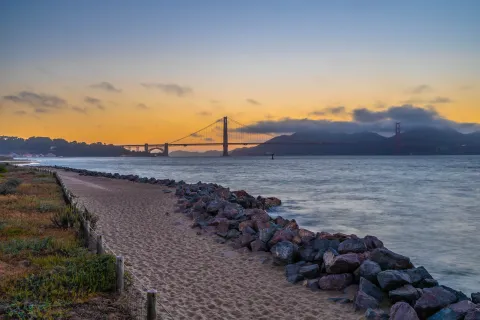
 0.5-1.0 hr stay
0.5-1.0 hr stay
Crissy Field (Free Entry)
1199 E Beach, san francisco
A former military airfield, Crissy Field transformed into a beloved national park site in 2001. This recreational paradise welcomes visitors and locals with its breathtaking San Francisco Bay views, easy hiking, beaches and picnic areas, and wild open spaces. Locals and visitors run, stroll, and cycle along the Bay Trail to the iconic Golden Gate Bridge. And the former airplane hangars and warehouses are home to recreational uses, from a rock climbing gym to a trampoline house. History buffs are served up a fascinating story from the past at the Military Intelligence Service Historic Learning Center.
- 0.9 MILES
- 22 minutes
- Get Directions

- 6:00am
- 6:15am
- 6:30am
- 6:45am
- 7:00am
- 7:15am
- 7:30am
- 7:45am
- 8:00am
- 8:15am
- 8:30am
- 8:45am
- 9:00am
- 9:15am
- 9:30am
- 9:45am
- 10:00am
- 10:15am
- 10:30am
- 10:45am
- 11:00am
- 11:15am
- 11:30am
- 11:45am
- 12:00pm
- 12:15pm
- 12:30pm
- 12:45pm
- 1:00pm
- 1:15pm
- 1:30pm
- 1:45pm
- 2:00pm
- 2:15pm
- 2:30pm
- 2:45pm
- 3:00pm
- 3:15pm
- 3:30pm
- 3:45pm
- 4:00pm
- 4:15pm
- 4:30pm
- 4:45pm
- 5:00pm
- 5:15pm
- 5:30pm
- 5:45pm
- 6:00pm
- 6:15pm
- 6:30pm
- 6:45pm
- 7:00pm
- 7:15pm
- 7:30pm
- 7:45pm
- 8:00pm
- 8:15pm
- 8:30pm
- 8:45pm
- 9:00pm
- 9:15pm
- 9:30pm
- 9:45pm
- 10:00pm
- 10:15pm
- 10:30pm
- 10:45pm
- 11:00pm
- 11:15pm
- 11:30pm
- 11:45pm
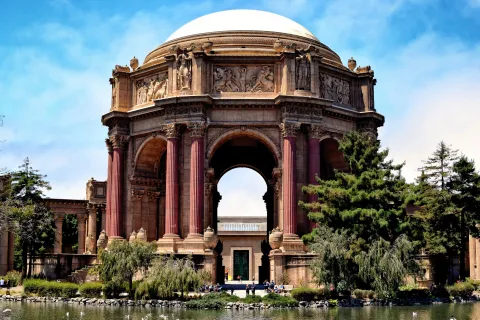
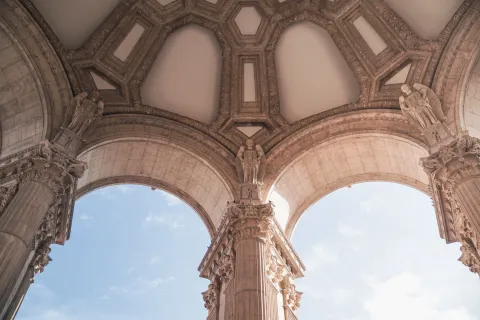
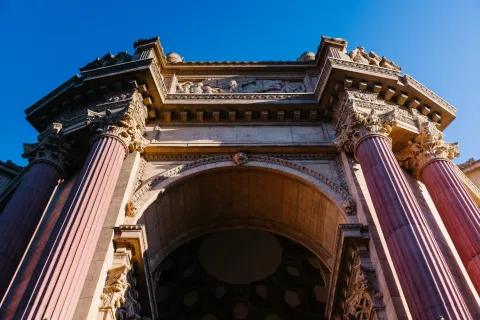
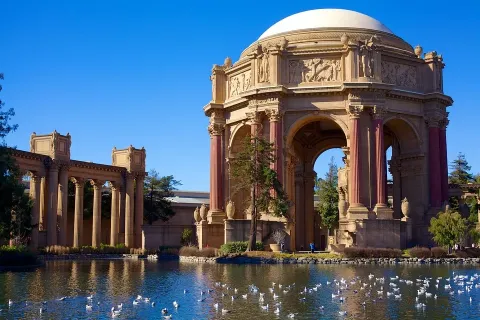
 0.5-1.0 hr stay
0.5-1.0 hr stay
Palace of Fine Arts (Free Entry)
3301 Lyon St, san francisco
Originally built for the 1915 Panama-Pacific Exhibition, this urban temple has become a San Francisco treasure, beloved by residents and visitors alike. The iconic Palace of Fine Arts, with its Greco-Roman style Rotunda and colonnades, is one of the most photographed sites in the City and has been featured in numerous film and TV productions. It’s also a popular wedding location and a spectacular performance venue.
- 0.6 MILES
- 14 minutes
- Get Directions

- 6:00am
- 6:15am
- 6:30am
- 6:45am
- 7:00am
- 7:15am
- 7:30am
- 7:45am
- 8:00am
- 8:15am
- 8:30am
- 8:45am
- 9:00am
- 9:15am
- 9:30am
- 9:45am
- 10:00am
- 10:15am
- 10:30am
- 10:45am
- 11:00am
- 11:15am
- 11:30am
- 11:45am
- 12:00pm
- 12:15pm
- 12:30pm
- 12:45pm
- 1:00pm
- 1:15pm
- 1:30pm
- 1:45pm
- 2:00pm
- 2:15pm
- 2:30pm
- 2:45pm
- 3:00pm
- 3:15pm
- 3:30pm
- 3:45pm
- 4:00pm
- 4:15pm
- 4:30pm
- 4:45pm
- 5:00pm
- 5:15pm
- 5:30pm
- 5:45pm
- 6:00pm
- 6:15pm
- 6:30pm
- 6:45pm
- 7:00pm
- 7:15pm
- 7:30pm
- 7:45pm
- 8:00pm
- 8:15pm
- 8:30pm
- 8:45pm
- 9:00pm
- 9:15pm
- 9:30pm
- 9:45pm
- 10:00pm
- 10:15pm
- 10:30pm
- 10:45pm
- 11:00pm
- 11:15pm
- 11:30pm
- 11:45pm
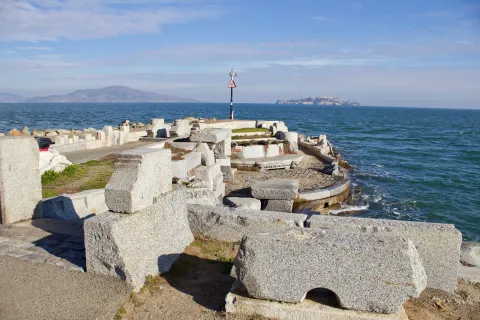
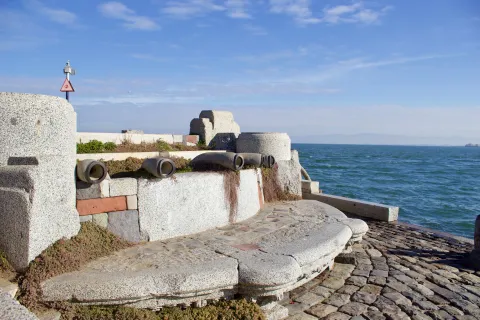
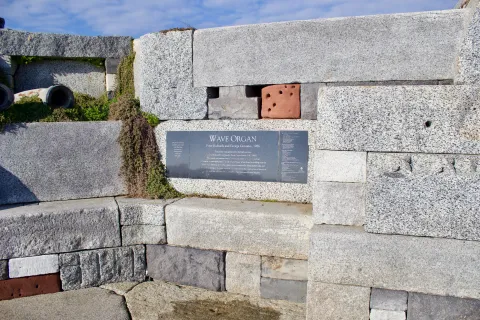
 0.5-1.0 hr stay
0.5-1.0 hr stay
The Wave Organ (Free Entry)
83 Marina Green Dr, san francisco
The Wave Organ, located on a small harbor (Jetty), is a wave-activated acoustic sculpture that produces the natural sound of waves. Former Exploratorium artists-in-residence Peter Richards and George Gonzalez created the wave organ in 1986 to amplify and showcase the natural sounds made by water and waves.

- 6:00am
- 6:15am
- 6:30am
- 6:45am
- 7:00am
- 7:15am
- 7:30am
- 7:45am
- 8:00am
- 8:15am
- 8:30am
- 8:45am
- 9:00am
- 9:15am
- 9:30am
- 9:45am
- 10:00am
- 10:15am
- 10:30am
- 10:45am
- 11:00am
- 11:15am
- 11:30am
- 11:45am
- 12:00pm
- 12:15pm
- 12:30pm
- 12:45pm
- 1:00pm
- 1:15pm
- 1:30pm
- 1:45pm
- 2:00pm
- 2:15pm
- 2:30pm
- 2:45pm
- 3:00pm
- 3:15pm
- 3:30pm
- 3:45pm
- 4:00pm
- 4:15pm
- 4:30pm
- 4:45pm
- 5:00pm
- 5:15pm
- 5:30pm
- 5:45pm
- 6:00pm
- 6:15pm
- 6:30pm
- 6:45pm
- 7:00pm
- 7:15pm
- 7:30pm
- 7:45pm
- 8:00pm
- 8:15pm
- 8:30pm
- 8:45pm
- 9:00pm
- 9:15pm
- 9:30pm
- 9:45pm
- 10:00pm
- 10:15pm
- 10:30pm
- 10:45pm
- 11:00pm
- 11:15pm
- 11:30pm
- 11:45pm
Eat DINNER

- 6:00am
- 6:15am
- 6:30am
- 6:45am
- 7:00am
- 7:15am
- 7:30am
- 7:45am
- 8:00am
- 8:15am
- 8:30am
- 8:45am
- 9:00am
- 9:15am
- 9:30am
- 9:45am
- 10:00am
- 10:15am
- 10:30am
- 10:45am
- 11:00am
- 11:15am
- 11:30am
- 11:45am
- 12:00pm
- 12:15pm
- 12:30pm
- 12:45pm
- 1:00pm
- 1:15pm
- 1:30pm
- 1:45pm
- 2:00pm
- 2:15pm
- 2:30pm
- 2:45pm
- 3:00pm
- 3:15pm
- 3:30pm
- 3:45pm
- 4:00pm
- 4:15pm
- 4:30pm
- 4:45pm
- 5:00pm
- 5:15pm
- 5:30pm
- 5:45pm
- 6:00pm
- 6:15pm
- 6:30pm
- 6:45pm
- 7:00pm
- 7:15pm
- 7:30pm
- 7:45pm
- 8:00pm
- 8:15pm
- 8:30pm
- 8:45pm
- 9:00pm
- 9:15pm
- 9:30pm
- 9:45pm
- 10:00pm
- 10:15pm
- 10:30pm
- 10:45pm
- 11:00pm
- 11:15pm
- 11:30pm
- 11:45pm
Eat BREAKFAST

- 6:00am
- 6:15am
- 6:30am
- 6:45am
- 7:00am
- 7:15am
- 7:30am
- 7:45am
- 8:00am
- 8:15am
- 8:30am
- 8:45am
- 9:00am
- 9:15am
- 9:30am
- 9:45am
- 10:00am
- 10:15am
- 10:30am
- 10:45am
- 11:00am
- 11:15am
- 11:30am
- 11:45am
- 12:00pm
- 12:15pm
- 12:30pm
- 12:45pm
- 1:00pm
- 1:15pm
- 1:30pm
- 1:45pm
- 2:00pm
- 2:15pm
- 2:30pm
- 2:45pm
- 3:00pm
- 3:15pm
- 3:30pm
- 3:45pm
- 4:00pm
- 4:15pm
- 4:30pm
- 4:45pm
- 5:00pm
- 5:15pm
- 5:30pm
- 5:45pm
- 6:00pm
- 6:15pm
- 6:30pm
- 6:45pm
- 7:00pm
- 7:15pm
- 7:30pm
- 7:45pm
- 8:00pm
- 8:15pm
- 8:30pm
- 8:45pm
- 9:00pm
- 9:15pm
- 9:30pm
- 9:45pm
- 10:00pm
- 10:15pm
- 10:30pm
- 10:45pm
- 11:00pm
- 11:15pm
- 11:30pm
- 11:45pm
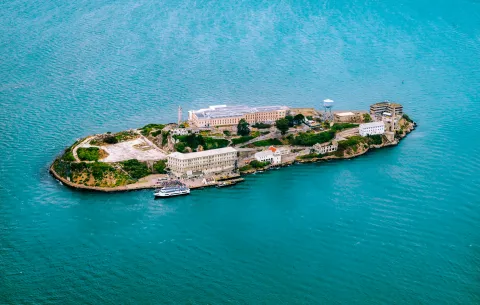
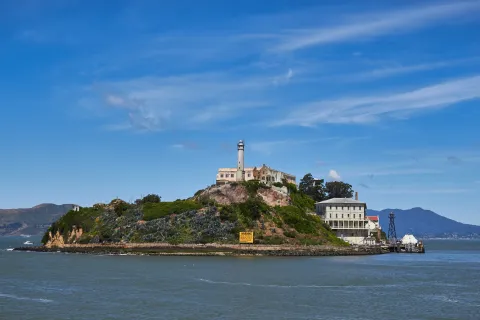
 1.0-3.0 hr stay
1.0-3.0 hr stay
Alcatraz Island ($$)
Alcatraz Island, san francisco
Alcatraz Island, aka “The Rock,” is a small island located 1.25 miles offshore from San Francisco in San Francisco Bay. It was a federal penitentiary housing some of America’s most notorious criminals from 1934-1963. The Island also served as a harbor defense fort and a military prison from 1969-1971. Once a maximum security prison, only three criminals (Frank Morris, John Anglin, and his brother Clarence Anglin) managed to escape from it; US Marshals Service is still looking for answers about their whereabouts. Alcatraz is one of San Francisco's most prominent landmarks and tourist attractions today.

- 6:00am
- 6:15am
- 6:30am
- 6:45am
- 7:00am
- 7:15am
- 7:30am
- 7:45am
- 8:00am
- 8:15am
- 8:30am
- 8:45am
- 9:00am
- 9:15am
- 9:30am
- 9:45am
- 10:00am
- 10:15am
- 10:30am
- 10:45am
- 11:00am
- 11:15am
- 11:30am
- 11:45am
- 12:00pm
- 12:15pm
- 12:30pm
- 12:45pm
- 1:00pm
- 1:15pm
- 1:30pm
- 1:45pm
- 2:00pm
- 2:15pm
- 2:30pm
- 2:45pm
- 3:00pm
- 3:15pm
- 3:30pm
- 3:45pm
- 4:00pm
- 4:15pm
- 4:30pm
- 4:45pm
- 5:00pm
- 5:15pm
- 5:30pm
- 5:45pm
- 6:00pm
- 6:15pm
- 6:30pm
- 6:45pm
- 7:00pm
- 7:15pm
- 7:30pm
- 7:45pm
- 8:00pm
- 8:15pm
- 8:30pm
- 8:45pm
- 9:00pm
- 9:15pm
- 9:30pm
- 9:45pm
- 10:00pm
- 10:15pm
- 10:30pm
- 10:45pm
- 11:00pm
- 11:15pm
- 11:30pm
- 11:45pm
Eat LUNCH

- 6:00am
- 6:15am
- 6:30am
- 6:45am
- 7:00am
- 7:15am
- 7:30am
- 7:45am
- 8:00am
- 8:15am
- 8:30am
- 8:45am
- 9:00am
- 9:15am
- 9:30am
- 9:45am
- 10:00am
- 10:15am
- 10:30am
- 10:45am
- 11:00am
- 11:15am
- 11:30am
- 11:45am
- 12:00pm
- 12:15pm
- 12:30pm
- 12:45pm
- 1:00pm
- 1:15pm
- 1:30pm
- 1:45pm
- 2:00pm
- 2:15pm
- 2:30pm
- 2:45pm
- 3:00pm
- 3:15pm
- 3:30pm
- 3:45pm
- 4:00pm
- 4:15pm
- 4:30pm
- 4:45pm
- 5:00pm
- 5:15pm
- 5:30pm
- 5:45pm
- 6:00pm
- 6:15pm
- 6:30pm
- 6:45pm
- 7:00pm
- 7:15pm
- 7:30pm
- 7:45pm
- 8:00pm
- 8:15pm
- 8:30pm
- 8:45pm
- 9:00pm
- 9:15pm
- 9:30pm
- 9:45pm
- 10:00pm
- 10:15pm
- 10:30pm
- 10:45pm
- 11:00pm
- 11:15pm
- 11:30pm
- 11:45pm
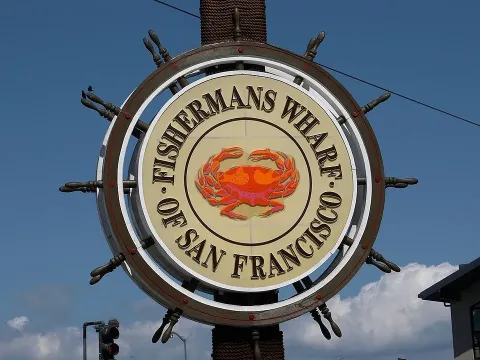
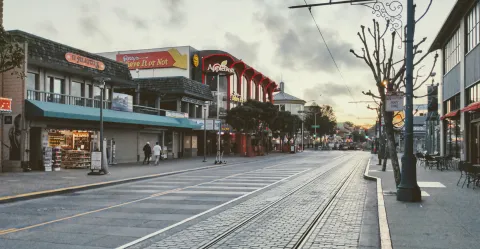
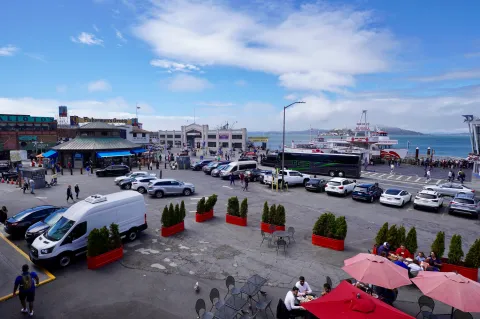
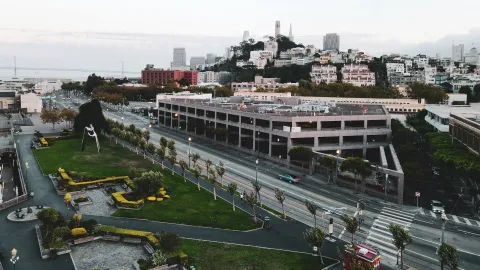
 1.0-4.0 hr stay
1.0-4.0 hr stay
Fisherman's Wharf & Pier 39 (Free Entry)
Fisherman's Wharf, san francisco
Fisherman’s Wharf is a popular tourist attraction and the most visited neighborhood in San Francisco, offering the gorgeous views of the Bay, Alcatraz, and the Golden Gate bridge. There is something for everyone in this beloved neighborhood. It is packed with things to fill the entire day, including world-class restaurants, rich maritime history, historic piers, exciting tours, attractions, street performances, museums, the aquarium, and shopping.

- 6:00am
- 6:15am
- 6:30am
- 6:45am
- 7:00am
- 7:15am
- 7:30am
- 7:45am
- 8:00am
- 8:15am
- 8:30am
- 8:45am
- 9:00am
- 9:15am
- 9:30am
- 9:45am
- 10:00am
- 10:15am
- 10:30am
- 10:45am
- 11:00am
- 11:15am
- 11:30am
- 11:45am
- 12:00pm
- 12:15pm
- 12:30pm
- 12:45pm
- 1:00pm
- 1:15pm
- 1:30pm
- 1:45pm
- 2:00pm
- 2:15pm
- 2:30pm
- 2:45pm
- 3:00pm
- 3:15pm
- 3:30pm
- 3:45pm
- 4:00pm
- 4:15pm
- 4:30pm
- 4:45pm
- 5:00pm
- 5:15pm
- 5:30pm
- 5:45pm
- 6:00pm
- 6:15pm
- 6:30pm
- 6:45pm
- 7:00pm
- 7:15pm
- 7:30pm
- 7:45pm
- 8:00pm
- 8:15pm
- 8:30pm
- 8:45pm
- 9:00pm
- 9:15pm
- 9:30pm
- 9:45pm
- 10:00pm
- 10:15pm
- 10:30pm
- 10:45pm
- 11:00pm
- 11:15pm
- 11:30pm
- 11:45pm
Eat DINNER

- 6:00am
- 6:15am
- 6:30am
- 6:45am
- 7:00am
- 7:15am
- 7:30am
- 7:45am
- 8:00am
- 8:15am
- 8:30am
- 8:45am
- 9:00am
- 9:15am
- 9:30am
- 9:45am
- 10:00am
- 10:15am
- 10:30am
- 10:45am
- 11:00am
- 11:15am
- 11:30am
- 11:45am
- 12:00pm
- 12:15pm
- 12:30pm
- 12:45pm
- 1:00pm
- 1:15pm
- 1:30pm
- 1:45pm
- 2:00pm
- 2:15pm
- 2:30pm
- 2:45pm
- 3:00pm
- 3:15pm
- 3:30pm
- 3:45pm
- 4:00pm
- 4:15pm
- 4:30pm
- 4:45pm
- 5:00pm
- 5:15pm
- 5:30pm
- 5:45pm
- 6:00pm
- 6:15pm
- 6:30pm
- 6:45pm
- 7:00pm
- 7:15pm
- 7:30pm
- 7:45pm
- 8:00pm
- 8:15pm
- 8:30pm
- 8:45pm
- 9:00pm
- 9:15pm
- 9:30pm
- 9:45pm
- 10:00pm
- 10:15pm
- 10:30pm
- 10:45pm
- 11:00pm
- 11:15pm
- 11:30pm
- 11:45pm
Eat BREAKFAST

- 6:00am
- 6:15am
- 6:30am
- 6:45am
- 7:00am
- 7:15am
- 7:30am
- 7:45am
- 8:00am
- 8:15am
- 8:30am
- 8:45am
- 9:00am
- 9:15am
- 9:30am
- 9:45am
- 10:00am
- 10:15am
- 10:30am
- 10:45am
- 11:00am
- 11:15am
- 11:30am
- 11:45am
- 12:00pm
- 12:15pm
- 12:30pm
- 12:45pm
- 1:00pm
- 1:15pm
- 1:30pm
- 1:45pm
- 2:00pm
- 2:15pm
- 2:30pm
- 2:45pm
- 3:00pm
- 3:15pm
- 3:30pm
- 3:45pm
- 4:00pm
- 4:15pm
- 4:30pm
- 4:45pm
- 5:00pm
- 5:15pm
- 5:30pm
- 5:45pm
- 6:00pm
- 6:15pm
- 6:30pm
- 6:45pm
- 7:00pm
- 7:15pm
- 7:30pm
- 7:45pm
- 8:00pm
- 8:15pm
- 8:30pm
- 8:45pm
- 9:00pm
- 9:15pm
- 9:30pm
- 9:45pm
- 10:00pm
- 10:15pm
- 10:30pm
- 10:45pm
- 11:00pm
- 11:15pm
- 11:30pm
- 11:45pm
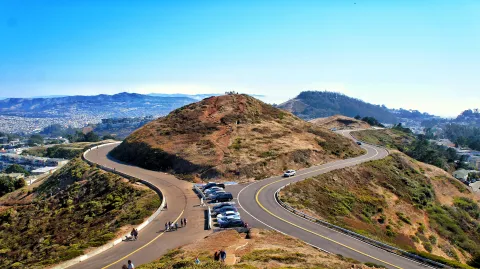
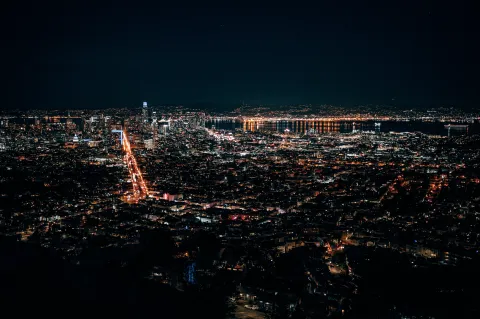
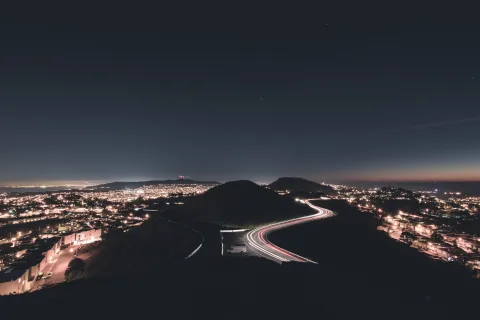
 0.5-1.0 hr stay
0.5-1.0 hr stay
Twin Peaks (Free Entry)
501 Twin Peaks Blvd, san francisco
Twin Peaks, at 922 feet in elevation, is a world-famous tourist attraction that offers spectacular views of the Bay Area. The north peak (aka Eureka Peak) and south peak (aka Noe Peak) provide postcard views and a treasure trove of animal and plant diversity. Most visitors to Twin Peaks drive, walk or bike to the north peak parking lot to enjoy 180-degree views of the Bay Area.
- 0.5 MILES
- 12 minutes
- Get Directions

- 6:00am
- 6:15am
- 6:30am
- 6:45am
- 7:00am
- 7:15am
- 7:30am
- 7:45am
- 8:00am
- 8:15am
- 8:30am
- 8:45am
- 9:00am
- 9:15am
- 9:30am
- 9:45am
- 10:00am
- 10:15am
- 10:30am
- 10:45am
- 11:00am
- 11:15am
- 11:30am
- 11:45am
- 12:00pm
- 12:15pm
- 12:30pm
- 12:45pm
- 1:00pm
- 1:15pm
- 1:30pm
- 1:45pm
- 2:00pm
- 2:15pm
- 2:30pm
- 2:45pm
- 3:00pm
- 3:15pm
- 3:30pm
- 3:45pm
- 4:00pm
- 4:15pm
- 4:30pm
- 4:45pm
- 5:00pm
- 5:15pm
- 5:30pm
- 5:45pm
- 6:00pm
- 6:15pm
- 6:30pm
- 6:45pm
- 7:00pm
- 7:15pm
- 7:30pm
- 7:45pm
- 8:00pm
- 8:15pm
- 8:30pm
- 8:45pm
- 9:00pm
- 9:15pm
- 9:30pm
- 9:45pm
- 10:00pm
- 10:15pm
- 10:30pm
- 10:45pm
- 11:00pm
- 11:15pm
- 11:30pm
- 11:45pm
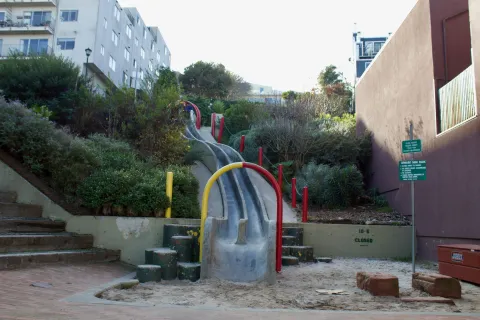
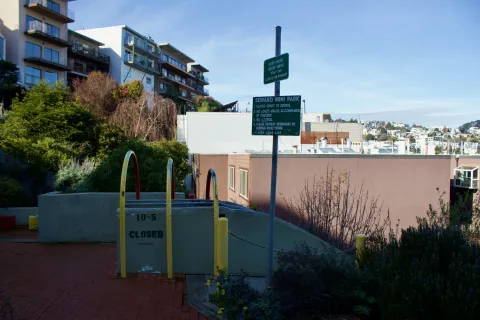
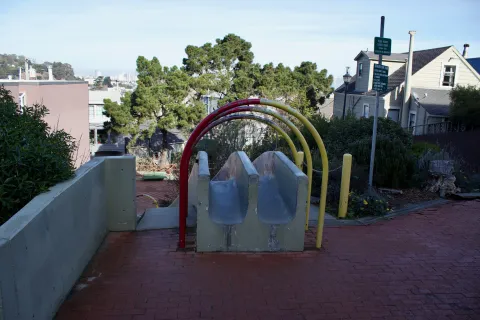
 0.25-0.5 hr stay
0.25-0.5 hr stay
Seward Street Slides (Free Entry)
30 Seward Street, san francisco
Seward Street slides are the two lanes of slippery downhill slides in a small park in the Noe Valley neighborhood in San Francisco. The slides represent the triumphant of neighborhood activism with a fascinating history. In 1963, this place was an empty lot with the development plans to build an apartment complex. Local residents protested, including staging a bulldozer-defying sit-in resulting in a change in the zoning laws and the land reserved for a small community park, including these slides.

- 6:00am
- 6:15am
- 6:30am
- 6:45am
- 7:00am
- 7:15am
- 7:30am
- 7:45am
- 8:00am
- 8:15am
- 8:30am
- 8:45am
- 9:00am
- 9:15am
- 9:30am
- 9:45am
- 10:00am
- 10:15am
- 10:30am
- 10:45am
- 11:00am
- 11:15am
- 11:30am
- 11:45am
- 12:00pm
- 12:15pm
- 12:30pm
- 12:45pm
- 1:00pm
- 1:15pm
- 1:30pm
- 1:45pm
- 2:00pm
- 2:15pm
- 2:30pm
- 2:45pm
- 3:00pm
- 3:15pm
- 3:30pm
- 3:45pm
- 4:00pm
- 4:15pm
- 4:30pm
- 4:45pm
- 5:00pm
- 5:15pm
- 5:30pm
- 5:45pm
- 6:00pm
- 6:15pm
- 6:30pm
- 6:45pm
- 7:00pm
- 7:15pm
- 7:30pm
- 7:45pm
- 8:00pm
- 8:15pm
- 8:30pm
- 8:45pm
- 9:00pm
- 9:15pm
- 9:30pm
- 9:45pm
- 10:00pm
- 10:15pm
- 10:30pm
- 10:45pm
- 11:00pm
- 11:15pm
- 11:30pm
- 11:45pm
Eat LUNCH

- 6:00am
- 6:15am
- 6:30am
- 6:45am
- 7:00am
- 7:15am
- 7:30am
- 7:45am
- 8:00am
- 8:15am
- 8:30am
- 8:45am
- 9:00am
- 9:15am
- 9:30am
- 9:45am
- 10:00am
- 10:15am
- 10:30am
- 10:45am
- 11:00am
- 11:15am
- 11:30am
- 11:45am
- 12:00pm
- 12:15pm
- 12:30pm
- 12:45pm
- 1:00pm
- 1:15pm
- 1:30pm
- 1:45pm
- 2:00pm
- 2:15pm
- 2:30pm
- 2:45pm
- 3:00pm
- 3:15pm
- 3:30pm
- 3:45pm
- 4:00pm
- 4:15pm
- 4:30pm
- 4:45pm
- 5:00pm
- 5:15pm
- 5:30pm
- 5:45pm
- 6:00pm
- 6:15pm
- 6:30pm
- 6:45pm
- 7:00pm
- 7:15pm
- 7:30pm
- 7:45pm
- 8:00pm
- 8:15pm
- 8:30pm
- 8:45pm
- 9:00pm
- 9:15pm
- 9:30pm
- 9:45pm
- 10:00pm
- 10:15pm
- 10:30pm
- 10:45pm
- 11:00pm
- 11:15pm
- 11:30pm
- 11:45pm
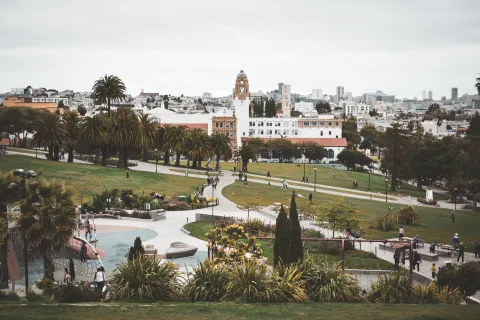
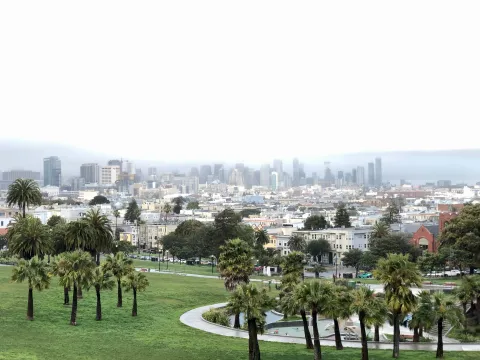
 0.5-1.5 hr stay
0.5-1.5 hr stay
Mission Dolores Park (Free Entry)
Dolores St &, 19th St, san francisco
Vibrant Mission Dolores park is a nearly 16-acre city park in the heart of its equally vibrant, culturally diverse mission district neighborhood. Lush green lawns shaded by tall palm trees, a soccer field, six tennis courts, one basketball field court, a multi-use court, a play ground, and two off-lease dog play areas adorn this beautiful park. Many festivals, performances, and other cultural events occur in the park. People flock to the park to play, picnic, lounge, walk their dogs, and enjoy spectacular views of the San Francisco skyline on sunny days.
- 0.7 MILES
- 17 minutes
- Get Directions

- 6:00am
- 6:15am
- 6:30am
- 6:45am
- 7:00am
- 7:15am
- 7:30am
- 7:45am
- 8:00am
- 8:15am
- 8:30am
- 8:45am
- 9:00am
- 9:15am
- 9:30am
- 9:45am
- 10:00am
- 10:15am
- 10:30am
- 10:45am
- 11:00am
- 11:15am
- 11:30am
- 11:45am
- 12:00pm
- 12:15pm
- 12:30pm
- 12:45pm
- 1:00pm
- 1:15pm
- 1:30pm
- 1:45pm
- 2:00pm
- 2:15pm
- 2:30pm
- 2:45pm
- 3:00pm
- 3:15pm
- 3:30pm
- 3:45pm
- 4:00pm
- 4:15pm
- 4:30pm
- 4:45pm
- 5:00pm
- 5:15pm
- 5:30pm
- 5:45pm
- 6:00pm
- 6:15pm
- 6:30pm
- 6:45pm
- 7:00pm
- 7:15pm
- 7:30pm
- 7:45pm
- 8:00pm
- 8:15pm
- 8:30pm
- 8:45pm
- 9:00pm
- 9:15pm
- 9:30pm
- 9:45pm
- 10:00pm
- 10:15pm
- 10:30pm
- 10:45pm
- 11:00pm
- 11:15pm
- 11:30pm
- 11:45pm
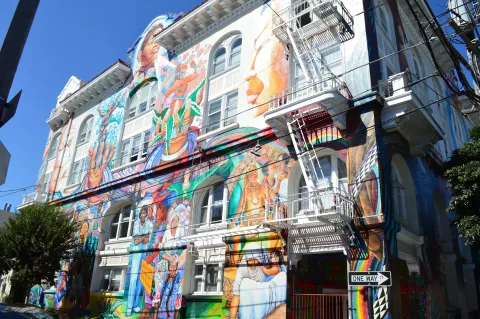
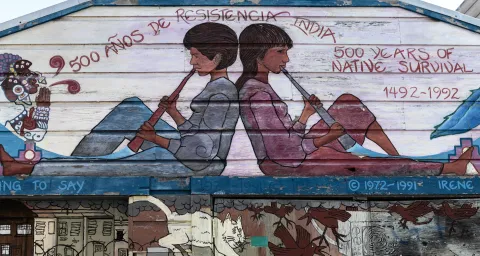
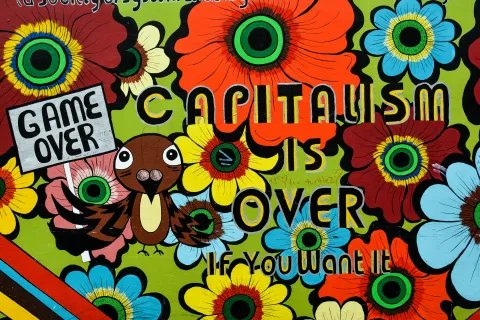
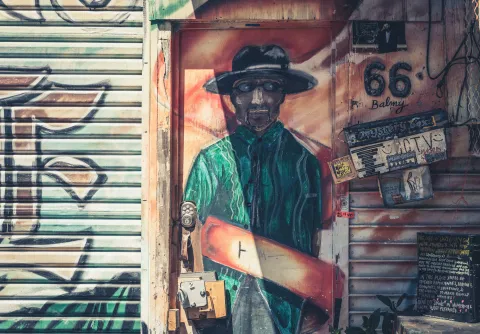
 0.5-1.0 hr stay
0.5-1.0 hr stay
Mission Murals (Free Entry)
24th St & Lilac St, san francisco
The famous mission murals are street art spread all over the mission district neighborhood showcasing immigrant experience, gentrification, and political landscape. Mission District murals tell a story that is very specific to San Francisco. Murals are in great shape; a few from the 1970s are fading or peeling away due to age.
- 1.8 MILES
- 43 minutes
- Get Directions

- 6:00am
- 6:15am
- 6:30am
- 6:45am
- 7:00am
- 7:15am
- 7:30am
- 7:45am
- 8:00am
- 8:15am
- 8:30am
- 8:45am
- 9:00am
- 9:15am
- 9:30am
- 9:45am
- 10:00am
- 10:15am
- 10:30am
- 10:45am
- 11:00am
- 11:15am
- 11:30am
- 11:45am
- 12:00pm
- 12:15pm
- 12:30pm
- 12:45pm
- 1:00pm
- 1:15pm
- 1:30pm
- 1:45pm
- 2:00pm
- 2:15pm
- 2:30pm
- 2:45pm
- 3:00pm
- 3:15pm
- 3:30pm
- 3:45pm
- 4:00pm
- 4:15pm
- 4:30pm
- 4:45pm
- 5:00pm
- 5:15pm
- 5:30pm
- 5:45pm
- 6:00pm
- 6:15pm
- 6:30pm
- 6:45pm
- 7:00pm
- 7:15pm
- 7:30pm
- 7:45pm
- 8:00pm
- 8:15pm
- 8:30pm
- 8:45pm
- 9:00pm
- 9:15pm
- 9:30pm
- 9:45pm
- 10:00pm
- 10:15pm
- 10:30pm
- 10:45pm
- 11:00pm
- 11:15pm
- 11:30pm
- 11:45pm
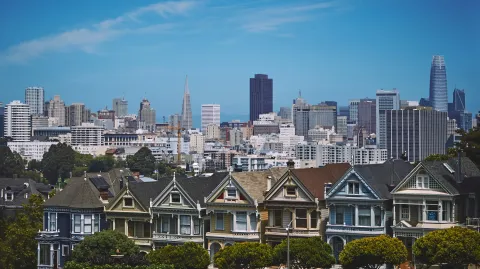
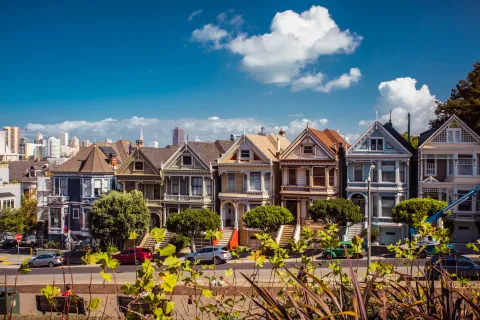
 0.5-1.0 hr stay
0.5-1.0 hr stay
Painted Ladies (Free Entry)
Steiner St & Hayes St, san francisco
Painted Ladies, aka “Postcard row,” are the most iconic and photographed pastel-colored houses on Steiner Street right next to each other. These houses symbolize the California Gold Rush. A lot of money came into the city, and people wanted to show their wealth with these beautiful extravagant homes.

- 6:00am
- 6:15am
- 6:30am
- 6:45am
- 7:00am
- 7:15am
- 7:30am
- 7:45am
- 8:00am
- 8:15am
- 8:30am
- 8:45am
- 9:00am
- 9:15am
- 9:30am
- 9:45am
- 10:00am
- 10:15am
- 10:30am
- 10:45am
- 11:00am
- 11:15am
- 11:30am
- 11:45am
- 12:00pm
- 12:15pm
- 12:30pm
- 12:45pm
- 1:00pm
- 1:15pm
- 1:30pm
- 1:45pm
- 2:00pm
- 2:15pm
- 2:30pm
- 2:45pm
- 3:00pm
- 3:15pm
- 3:30pm
- 3:45pm
- 4:00pm
- 4:15pm
- 4:30pm
- 4:45pm
- 5:00pm
- 5:15pm
- 5:30pm
- 5:45pm
- 6:00pm
- 6:15pm
- 6:30pm
- 6:45pm
- 7:00pm
- 7:15pm
- 7:30pm
- 7:45pm
- 8:00pm
- 8:15pm
- 8:30pm
- 8:45pm
- 9:00pm
- 9:15pm
- 9:30pm
- 9:45pm
- 10:00pm
- 10:15pm
- 10:30pm
- 10:45pm
- 11:00pm
- 11:15pm
- 11:30pm
- 11:45pm
Eat DINNER

- 6:00am
- 6:15am
- 6:30am
- 6:45am
- 7:00am
- 7:15am
- 7:30am
- 7:45am
- 8:00am
- 8:15am
- 8:30am
- 8:45am
- 9:00am
- 9:15am
- 9:30am
- 9:45am
- 10:00am
- 10:15am
- 10:30am
- 10:45am
- 11:00am
- 11:15am
- 11:30am
- 11:45am
- 12:00pm
- 12:15pm
- 12:30pm
- 12:45pm
- 1:00pm
- 1:15pm
- 1:30pm
- 1:45pm
- 2:00pm
- 2:15pm
- 2:30pm
- 2:45pm
- 3:00pm
- 3:15pm
- 3:30pm
- 3:45pm
- 4:00pm
- 4:15pm
- 4:30pm
- 4:45pm
- 5:00pm
- 5:15pm
- 5:30pm
- 5:45pm
- 6:00pm
- 6:15pm
- 6:30pm
- 6:45pm
- 7:00pm
- 7:15pm
- 7:30pm
- 7:45pm
- 8:00pm
- 8:15pm
- 8:30pm
- 8:45pm
- 9:00pm
- 9:15pm
- 9:30pm
- 9:45pm
- 10:00pm
- 10:15pm
- 10:30pm
- 10:45pm
- 11:00pm
- 11:15pm
- 11:30pm
- 11:45pm
Eat BREAKFAST

- 6:00am
- 6:15am
- 6:30am
- 6:45am
- 7:00am
- 7:15am
- 7:30am
- 7:45am
- 8:00am
- 8:15am
- 8:30am
- 8:45am
- 9:00am
- 9:15am
- 9:30am
- 9:45am
- 10:00am
- 10:15am
- 10:30am
- 10:45am
- 11:00am
- 11:15am
- 11:30am
- 11:45am
- 12:00pm
- 12:15pm
- 12:30pm
- 12:45pm
- 1:00pm
- 1:15pm
- 1:30pm
- 1:45pm
- 2:00pm
- 2:15pm
- 2:30pm
- 2:45pm
- 3:00pm
- 3:15pm
- 3:30pm
- 3:45pm
- 4:00pm
- 4:15pm
- 4:30pm
- 4:45pm
- 5:00pm
- 5:15pm
- 5:30pm
- 5:45pm
- 6:00pm
- 6:15pm
- 6:30pm
- 6:45pm
- 7:00pm
- 7:15pm
- 7:30pm
- 7:45pm
- 8:00pm
- 8:15pm
- 8:30pm
- 8:45pm
- 9:00pm
- 9:15pm
- 9:30pm
- 9:45pm
- 10:00pm
- 10:15pm
- 10:30pm
- 10:45pm
- 11:00pm
- 11:15pm
- 11:30pm
- 11:45pm
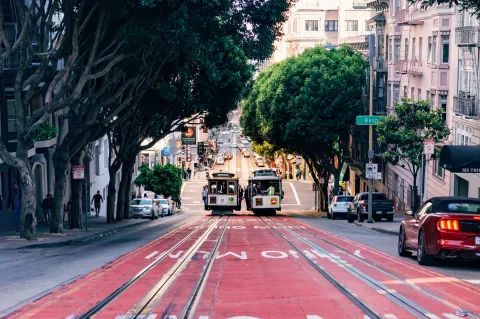
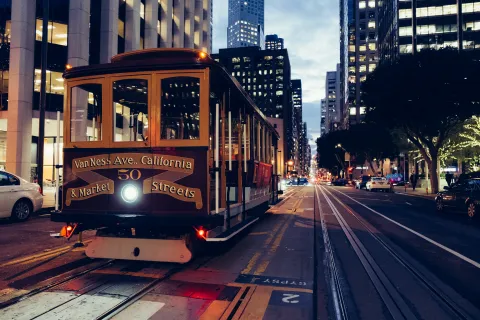
 0.5-1.0 hr stay
0.5-1.0 hr stay
Cable Car System ($)
Powell St & Market St, san francisco
A visit to San Francisco is only complete with riding the postcard-perfect moving national landmark, the Cable Cars. Unique to San Francisco, cable cars are pulled along by cables running beneath the street. Andrew Smith Hallidie got the inspiration for Cable Cars after seeing an accident when a horse-drawn streetcar slid backward under its heavy load in 1869. Cable cars launched after four years in 1873.
- 0.3 MILES
- 7 minutes
- Get Directions

- 6:00am
- 6:15am
- 6:30am
- 6:45am
- 7:00am
- 7:15am
- 7:30am
- 7:45am
- 8:00am
- 8:15am
- 8:30am
- 8:45am
- 9:00am
- 9:15am
- 9:30am
- 9:45am
- 10:00am
- 10:15am
- 10:30am
- 10:45am
- 11:00am
- 11:15am
- 11:30am
- 11:45am
- 12:00pm
- 12:15pm
- 12:30pm
- 12:45pm
- 1:00pm
- 1:15pm
- 1:30pm
- 1:45pm
- 2:00pm
- 2:15pm
- 2:30pm
- 2:45pm
- 3:00pm
- 3:15pm
- 3:30pm
- 3:45pm
- 4:00pm
- 4:15pm
- 4:30pm
- 4:45pm
- 5:00pm
- 5:15pm
- 5:30pm
- 5:45pm
- 6:00pm
- 6:15pm
- 6:30pm
- 6:45pm
- 7:00pm
- 7:15pm
- 7:30pm
- 7:45pm
- 8:00pm
- 8:15pm
- 8:30pm
- 8:45pm
- 9:00pm
- 9:15pm
- 9:30pm
- 9:45pm
- 10:00pm
- 10:15pm
- 10:30pm
- 10:45pm
- 11:00pm
- 11:15pm
- 11:30pm
- 11:45pm
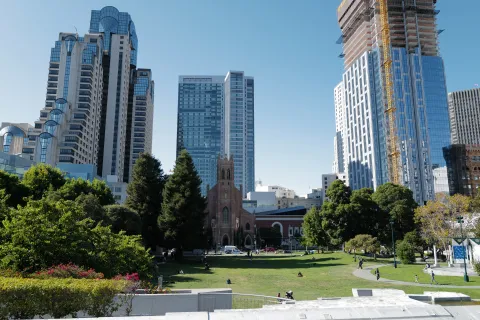
 0.5-1.0 hr stay
0.5-1.0 hr stay
Yerba Buena Gardens (Free Entry)
750 Howard St, san francisco
Yerba Buena Gardens is the perfect place to relax, explore, play, dine or shop in the heart of San Francisco’s downtown. The park will enlighten every mood, celebrate diversity, and find green relief while discovering unique features, renowned museums, cafes, memorials, and theaters—all cradled by landscaped lawns, public art, and award-winning architecture.

- 6:00am
- 6:15am
- 6:30am
- 6:45am
- 7:00am
- 7:15am
- 7:30am
- 7:45am
- 8:00am
- 8:15am
- 8:30am
- 8:45am
- 9:00am
- 9:15am
- 9:30am
- 9:45am
- 10:00am
- 10:15am
- 10:30am
- 10:45am
- 11:00am
- 11:15am
- 11:30am
- 11:45am
- 12:00pm
- 12:15pm
- 12:30pm
- 12:45pm
- 1:00pm
- 1:15pm
- 1:30pm
- 1:45pm
- 2:00pm
- 2:15pm
- 2:30pm
- 2:45pm
- 3:00pm
- 3:15pm
- 3:30pm
- 3:45pm
- 4:00pm
- 4:15pm
- 4:30pm
- 4:45pm
- 5:00pm
- 5:15pm
- 5:30pm
- 5:45pm
- 6:00pm
- 6:15pm
- 6:30pm
- 6:45pm
- 7:00pm
- 7:15pm
- 7:30pm
- 7:45pm
- 8:00pm
- 8:15pm
- 8:30pm
- 8:45pm
- 9:00pm
- 9:15pm
- 9:30pm
- 9:45pm
- 10:00pm
- 10:15pm
- 10:30pm
- 10:45pm
- 11:00pm
- 11:15pm
- 11:30pm
- 11:45pm
Eat LUNCH

- 6:00am
- 6:15am
- 6:30am
- 6:45am
- 7:00am
- 7:15am
- 7:30am
- 7:45am
- 8:00am
- 8:15am
- 8:30am
- 8:45am
- 9:00am
- 9:15am
- 9:30am
- 9:45am
- 10:00am
- 10:15am
- 10:30am
- 10:45am
- 11:00am
- 11:15am
- 11:30am
- 11:45am
- 12:00pm
- 12:15pm
- 12:30pm
- 12:45pm
- 1:00pm
- 1:15pm
- 1:30pm
- 1:45pm
- 2:00pm
- 2:15pm
- 2:30pm
- 2:45pm
- 3:00pm
- 3:15pm
- 3:30pm
- 3:45pm
- 4:00pm
- 4:15pm
- 4:30pm
- 4:45pm
- 5:00pm
- 5:15pm
- 5:30pm
- 5:45pm
- 6:00pm
- 6:15pm
- 6:30pm
- 6:45pm
- 7:00pm
- 7:15pm
- 7:30pm
- 7:45pm
- 8:00pm
- 8:15pm
- 8:30pm
- 8:45pm
- 9:00pm
- 9:15pm
- 9:30pm
- 9:45pm
- 10:00pm
- 10:15pm
- 10:30pm
- 10:45pm
- 11:00pm
- 11:15pm
- 11:30pm
- 11:45pm
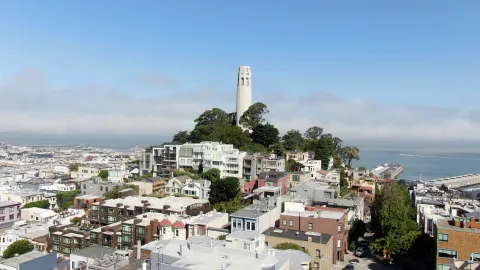
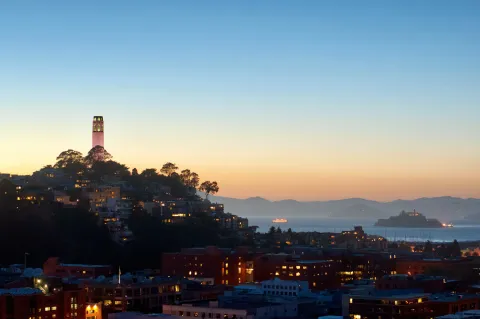
 0.5-1.0 hr stay
0.5-1.0 hr stay
Coit Tower ($)
1 Telegraph Hill Blvd, san francisco
Coit Tower is a slender 210 feet high white concrete column rising from the top of Telegraph Hill. The tower has been an emblem of San Francisco’s skyline since its completion in 1933, a welcoming beacon to visitors and residents alike. Its observation deck, reached by elevator (tickets are available in the gift shop), provides 360-degree views of the city and bay, including the Golden Gate and Bay bridges. It is named after Lillie Hitchcock Coit, a wealthy eccentric and patron of the city’s firefighters who died in 1929, leaving a substantial bequest “for the purpose of adding to the beauty of the city I have always loved.”
- 4.2 MILES
- 101 minutes
- Get Directions

- 6:00am
- 6:15am
- 6:30am
- 6:45am
- 7:00am
- 7:15am
- 7:30am
- 7:45am
- 8:00am
- 8:15am
- 8:30am
- 8:45am
- 9:00am
- 9:15am
- 9:30am
- 9:45am
- 10:00am
- 10:15am
- 10:30am
- 10:45am
- 11:00am
- 11:15am
- 11:30am
- 11:45am
- 12:00pm
- 12:15pm
- 12:30pm
- 12:45pm
- 1:00pm
- 1:15pm
- 1:30pm
- 1:45pm
- 2:00pm
- 2:15pm
- 2:30pm
- 2:45pm
- 3:00pm
- 3:15pm
- 3:30pm
- 3:45pm
- 4:00pm
- 4:15pm
- 4:30pm
- 4:45pm
- 5:00pm
- 5:15pm
- 5:30pm
- 5:45pm
- 6:00pm
- 6:15pm
- 6:30pm
- 6:45pm
- 7:00pm
- 7:15pm
- 7:30pm
- 7:45pm
- 8:00pm
- 8:15pm
- 8:30pm
- 8:45pm
- 9:00pm
- 9:15pm
- 9:30pm
- 9:45pm
- 10:00pm
- 10:15pm
- 10:30pm
- 10:45pm
- 11:00pm
- 11:15pm
- 11:30pm
- 11:45pm
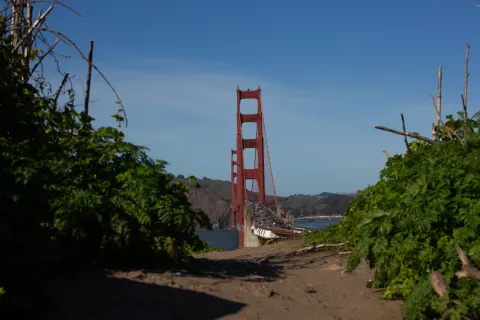
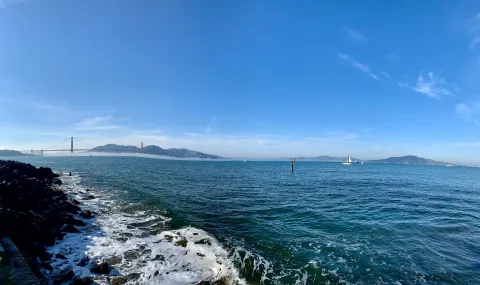
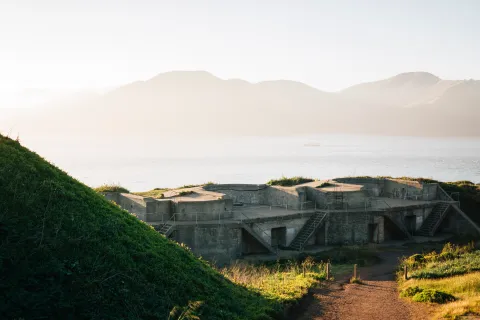
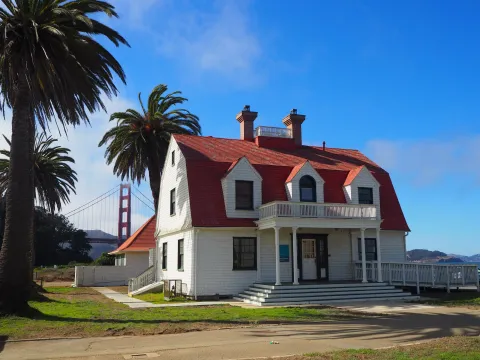
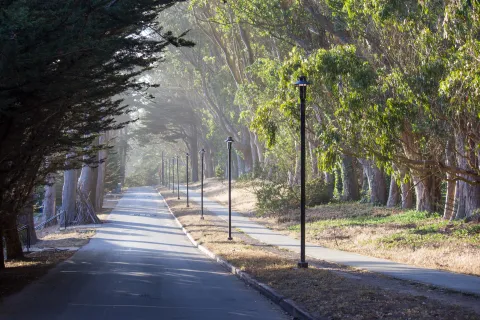
 1.0-2.5 hr stay
1.0-2.5 hr stay
Presidio of San Francisco (Free Entry)
Presidio of San Francisco, san francisco
The Presidio of San Francisco is one of America’s most famous national park sites, with more than 700 structures, a 300-acre historic forest, and 300 bird species. Located at the Golden Gate, it’s a place to escape in nature and explore key moments in history. The park features San Francisco’s best hiking and biking trails, scenic overlooks, picnic sites, beaches, a golf course, and other top attractions. The Presidio is also home to one of the nation's finest collections of fortifications, landscapes, buildings, structures, and artifacts related to military history.

- 6:00am
- 6:15am
- 6:30am
- 6:45am
- 7:00am
- 7:15am
- 7:30am
- 7:45am
- 8:00am
- 8:15am
- 8:30am
- 8:45am
- 9:00am
- 9:15am
- 9:30am
- 9:45am
- 10:00am
- 10:15am
- 10:30am
- 10:45am
- 11:00am
- 11:15am
- 11:30am
- 11:45am
- 12:00pm
- 12:15pm
- 12:30pm
- 12:45pm
- 1:00pm
- 1:15pm
- 1:30pm
- 1:45pm
- 2:00pm
- 2:15pm
- 2:30pm
- 2:45pm
- 3:00pm
- 3:15pm
- 3:30pm
- 3:45pm
- 4:00pm
- 4:15pm
- 4:30pm
- 4:45pm
- 5:00pm
- 5:15pm
- 5:30pm
- 5:45pm
- 6:00pm
- 6:15pm
- 6:30pm
- 6:45pm
- 7:00pm
- 7:15pm
- 7:30pm
- 7:45pm
- 8:00pm
- 8:15pm
- 8:30pm
- 8:45pm
- 9:00pm
- 9:15pm
- 9:30pm
- 9:45pm
- 10:00pm
- 10:15pm
- 10:30pm
- 10:45pm
- 11:00pm
- 11:15pm
- 11:30pm
- 11:45pm
Eat DINNER

- 6:00am
- 6:15am
- 6:30am
- 6:45am
- 7:00am
- 7:15am
- 7:30am
- 7:45am
- 8:00am
- 8:15am
- 8:30am
- 8:45am
- 9:00am
- 9:15am
- 9:30am
- 9:45am
- 10:00am
- 10:15am
- 10:30am
- 10:45am
- 11:00am
- 11:15am
- 11:30am
- 11:45am
- 12:00pm
- 12:15pm
- 12:30pm
- 12:45pm
- 1:00pm
- 1:15pm
- 1:30pm
- 1:45pm
- 2:00pm
- 2:15pm
- 2:30pm
- 2:45pm
- 3:00pm
- 3:15pm
- 3:30pm
- 3:45pm
- 4:00pm
- 4:15pm
- 4:30pm
- 4:45pm
- 5:00pm
- 5:15pm
- 5:30pm
- 5:45pm
- 6:00pm
- 6:15pm
- 6:30pm
- 6:45pm
- 7:00pm
- 7:15pm
- 7:30pm
- 7:45pm
- 8:00pm
- 8:15pm
- 8:30pm
- 8:45pm
- 9:00pm
- 9:15pm
- 9:30pm
- 9:45pm
- 10:00pm
- 10:15pm
- 10:30pm
- 10:45pm
- 11:00pm
- 11:15pm
- 11:30pm
- 11:45pm
Eat BREAKFAST

- 6:00am
- 6:15am
- 6:30am
- 6:45am
- 7:00am
- 7:15am
- 7:30am
- 7:45am
- 8:00am
- 8:15am
- 8:30am
- 8:45am
- 9:00am
- 9:15am
- 9:30am
- 9:45am
- 10:00am
- 10:15am
- 10:30am
- 10:45am
- 11:00am
- 11:15am
- 11:30am
- 11:45am
- 12:00pm
- 12:15pm
- 12:30pm
- 12:45pm
- 1:00pm
- 1:15pm
- 1:30pm
- 1:45pm
- 2:00pm
- 2:15pm
- 2:30pm
- 2:45pm
- 3:00pm
- 3:15pm
- 3:30pm
- 3:45pm
- 4:00pm
- 4:15pm
- 4:30pm
- 4:45pm
- 5:00pm
- 5:15pm
- 5:30pm
- 5:45pm
- 6:00pm
- 6:15pm
- 6:30pm
- 6:45pm
- 7:00pm
- 7:15pm
- 7:30pm
- 7:45pm
- 8:00pm
- 8:15pm
- 8:30pm
- 8:45pm
- 9:00pm
- 9:15pm
- 9:30pm
- 9:45pm
- 10:00pm
- 10:15pm
- 10:30pm
- 10:45pm
- 11:00pm
- 11:15pm
- 11:30pm
- 11:45pm
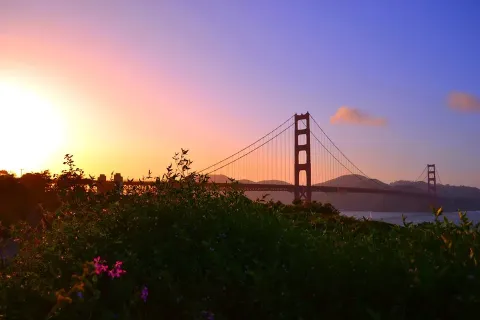
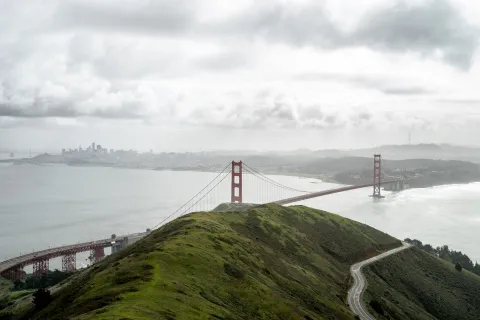
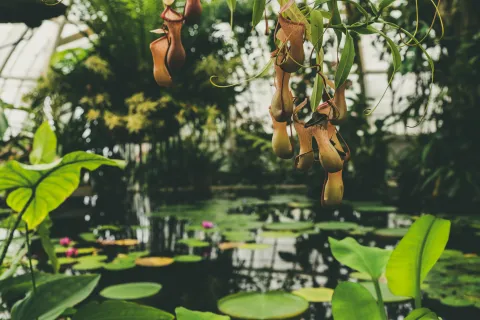
 1.0-2.5 hr stay
1.0-2.5 hr stay
Golden Gate Park (Free Entry)
Golden Gate Park, san francisco
Golden Gate Park is the iconic 1,017 acres urban park, a garden oasis, and the third most visited park in the United States. The park is free to see, but there are popular attractions such as the de Young Museum, California Academy of Science, Conservatory of flowers, etc., charge admission. It is a place where people can relax and reconnect with the natural world. Two of the City’s most impressive museums are found in Golden Gate Park. The park is filled with gardens, museums, art, flowers, trees, lakes, birds, and wildlife. There are also plenty of opportunities to participate in sports, clubs, and other activities. Golden Gate Park has something for everyone.

- 6:00am
- 6:15am
- 6:30am
- 6:45am
- 7:00am
- 7:15am
- 7:30am
- 7:45am
- 8:00am
- 8:15am
- 8:30am
- 8:45am
- 9:00am
- 9:15am
- 9:30am
- 9:45am
- 10:00am
- 10:15am
- 10:30am
- 10:45am
- 11:00am
- 11:15am
- 11:30am
- 11:45am
- 12:00pm
- 12:15pm
- 12:30pm
- 12:45pm
- 1:00pm
- 1:15pm
- 1:30pm
- 1:45pm
- 2:00pm
- 2:15pm
- 2:30pm
- 2:45pm
- 3:00pm
- 3:15pm
- 3:30pm
- 3:45pm
- 4:00pm
- 4:15pm
- 4:30pm
- 4:45pm
- 5:00pm
- 5:15pm
- 5:30pm
- 5:45pm
- 6:00pm
- 6:15pm
- 6:30pm
- 6:45pm
- 7:00pm
- 7:15pm
- 7:30pm
- 7:45pm
- 8:00pm
- 8:15pm
- 8:30pm
- 8:45pm
- 9:00pm
- 9:15pm
- 9:30pm
- 9:45pm
- 10:00pm
- 10:15pm
- 10:30pm
- 10:45pm
- 11:00pm
- 11:15pm
- 11:30pm
- 11:45pm
Eat LUNCH

- 6:00am
- 6:15am
- 6:30am
- 6:45am
- 7:00am
- 7:15am
- 7:30am
- 7:45am
- 8:00am
- 8:15am
- 8:30am
- 8:45am
- 9:00am
- 9:15am
- 9:30am
- 9:45am
- 10:00am
- 10:15am
- 10:30am
- 10:45am
- 11:00am
- 11:15am
- 11:30am
- 11:45am
- 12:00pm
- 12:15pm
- 12:30pm
- 12:45pm
- 1:00pm
- 1:15pm
- 1:30pm
- 1:45pm
- 2:00pm
- 2:15pm
- 2:30pm
- 2:45pm
- 3:00pm
- 3:15pm
- 3:30pm
- 3:45pm
- 4:00pm
- 4:15pm
- 4:30pm
- 4:45pm
- 5:00pm
- 5:15pm
- 5:30pm
- 5:45pm
- 6:00pm
- 6:15pm
- 6:30pm
- 6:45pm
- 7:00pm
- 7:15pm
- 7:30pm
- 7:45pm
- 8:00pm
- 8:15pm
- 8:30pm
- 8:45pm
- 9:00pm
- 9:15pm
- 9:30pm
- 9:45pm
- 10:00pm
- 10:15pm
- 10:30pm
- 10:45pm
- 11:00pm
- 11:15pm
- 11:30pm
- 11:45pm
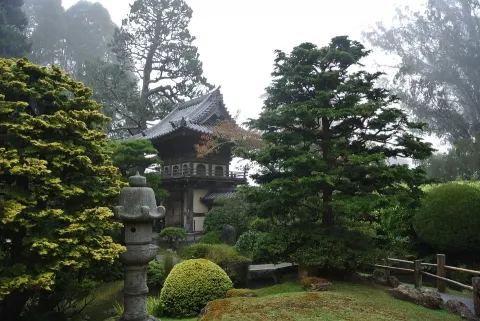
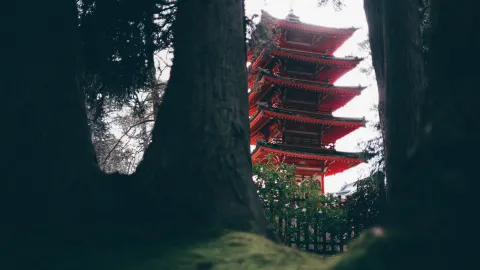
 0.5-1.5 hr stay
0.5-1.5 hr stay
Japanese Tea Garden ($)
75 Hagiwara Tea Garden Dr, san francisco
The Japanese Tea Garden offers visitors the natural beauty, tranquility, and harmony of a Japanese-style garden in the heart of San Francisco’s Golden Gate Park. It was created as a “Japanese Village” exhibit for the 1894 California Midwinter International Exposition. Later, Japanese landscape architect Makoto Hagiwara expanded the garden from 1 acre to its current size of approximately 5 acres.
- 0.2 MILES
- 5 minutes
- Get Directions

- 6:00am
- 6:15am
- 6:30am
- 6:45am
- 7:00am
- 7:15am
- 7:30am
- 7:45am
- 8:00am
- 8:15am
- 8:30am
- 8:45am
- 9:00am
- 9:15am
- 9:30am
- 9:45am
- 10:00am
- 10:15am
- 10:30am
- 10:45am
- 11:00am
- 11:15am
- 11:30am
- 11:45am
- 12:00pm
- 12:15pm
- 12:30pm
- 12:45pm
- 1:00pm
- 1:15pm
- 1:30pm
- 1:45pm
- 2:00pm
- 2:15pm
- 2:30pm
- 2:45pm
- 3:00pm
- 3:15pm
- 3:30pm
- 3:45pm
- 4:00pm
- 4:15pm
- 4:30pm
- 4:45pm
- 5:00pm
- 5:15pm
- 5:30pm
- 5:45pm
- 6:00pm
- 6:15pm
- 6:30pm
- 6:45pm
- 7:00pm
- 7:15pm
- 7:30pm
- 7:45pm
- 8:00pm
- 8:15pm
- 8:30pm
- 8:45pm
- 9:00pm
- 9:15pm
- 9:30pm
- 9:45pm
- 10:00pm
- 10:15pm
- 10:30pm
- 10:45pm
- 11:00pm
- 11:15pm
- 11:30pm
- 11:45pm

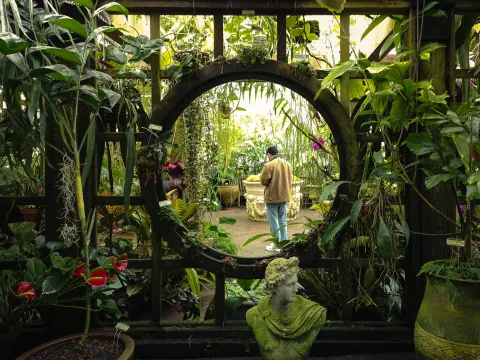
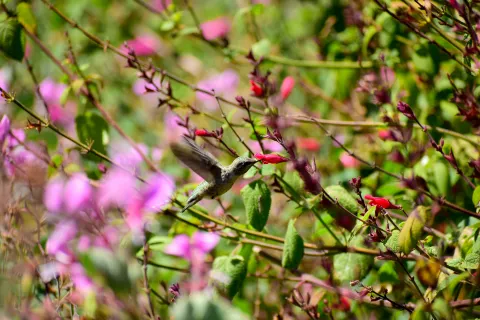
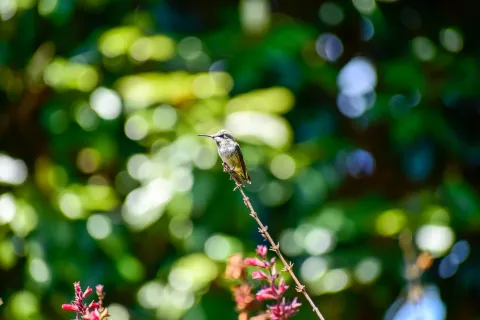
 1.0-2.0 hr stay
1.0-2.0 hr stay
San Francisco Botanical Garden ($)
1199 9th Ave, san francisco
San Francisco Botanical Garden is a unique urban oasis of extraordinary beauty showcasing 8,000 different kinds of plants from around the world. It is 55 acres of green space with beautiful trails with plenty of signs and information.

- 6:00am
- 6:15am
- 6:30am
- 6:45am
- 7:00am
- 7:15am
- 7:30am
- 7:45am
- 8:00am
- 8:15am
- 8:30am
- 8:45am
- 9:00am
- 9:15am
- 9:30am
- 9:45am
- 10:00am
- 10:15am
- 10:30am
- 10:45am
- 11:00am
- 11:15am
- 11:30am
- 11:45am
- 12:00pm
- 12:15pm
- 12:30pm
- 12:45pm
- 1:00pm
- 1:15pm
- 1:30pm
- 1:45pm
- 2:00pm
- 2:15pm
- 2:30pm
- 2:45pm
- 3:00pm
- 3:15pm
- 3:30pm
- 3:45pm
- 4:00pm
- 4:15pm
- 4:30pm
- 4:45pm
- 5:00pm
- 5:15pm
- 5:30pm
- 5:45pm
- 6:00pm
- 6:15pm
- 6:30pm
- 6:45pm
- 7:00pm
- 7:15pm
- 7:30pm
- 7:45pm
- 8:00pm
- 8:15pm
- 8:30pm
- 8:45pm
- 9:00pm
- 9:15pm
- 9:30pm
- 9:45pm
- 10:00pm
- 10:15pm
- 10:30pm
- 10:45pm
- 11:00pm
- 11:15pm
- 11:30pm
- 11:45pm
Eat DINNER

- 6:00am
- 6:15am
- 6:30am
- 6:45am
- 7:00am
- 7:15am
- 7:30am
- 7:45am
- 8:00am
- 8:15am
- 8:30am
- 8:45am
- 9:00am
- 9:15am
- 9:30am
- 9:45am
- 10:00am
- 10:15am
- 10:30am
- 10:45am
- 11:00am
- 11:15am
- 11:30am
- 11:45am
- 12:00pm
- 12:15pm
- 12:30pm
- 12:45pm
- 1:00pm
- 1:15pm
- 1:30pm
- 1:45pm
- 2:00pm
- 2:15pm
- 2:30pm
- 2:45pm
- 3:00pm
- 3:15pm
- 3:30pm
- 3:45pm
- 4:00pm
- 4:15pm
- 4:30pm
- 4:45pm
- 5:00pm
- 5:15pm
- 5:30pm
- 5:45pm
- 6:00pm
- 6:15pm
- 6:30pm
- 6:45pm
- 7:00pm
- 7:15pm
- 7:30pm
- 7:45pm
- 8:00pm
- 8:15pm
- 8:30pm
- 8:45pm
- 9:00pm
- 9:15pm
- 9:30pm
- 9:45pm
- 10:00pm
- 10:15pm
- 10:30pm
- 10:45pm
- 11:00pm
- 11:15pm
- 11:30pm
- 11:45pm
Eat BREAKFAST

- 6:00am
- 6:15am
- 6:30am
- 6:45am
- 7:00am
- 7:15am
- 7:30am
- 7:45am
- 8:00am
- 8:15am
- 8:30am
- 8:45am
- 9:00am
- 9:15am
- 9:30am
- 9:45am
- 10:00am
- 10:15am
- 10:30am
- 10:45am
- 11:00am
- 11:15am
- 11:30am
- 11:45am
- 12:00pm
- 12:15pm
- 12:30pm
- 12:45pm
- 1:00pm
- 1:15pm
- 1:30pm
- 1:45pm
- 2:00pm
- 2:15pm
- 2:30pm
- 2:45pm
- 3:00pm
- 3:15pm
- 3:30pm
- 3:45pm
- 4:00pm
- 4:15pm
- 4:30pm
- 4:45pm
- 5:00pm
- 5:15pm
- 5:30pm
- 5:45pm
- 6:00pm
- 6:15pm
- 6:30pm
- 6:45pm
- 7:00pm
- 7:15pm
- 7:30pm
- 7:45pm
- 8:00pm
- 8:15pm
- 8:30pm
- 8:45pm
- 9:00pm
- 9:15pm
- 9:30pm
- 9:45pm
- 10:00pm
- 10:15pm
- 10:30pm
- 10:45pm
- 11:00pm
- 11:15pm
- 11:30pm
- 11:45pm
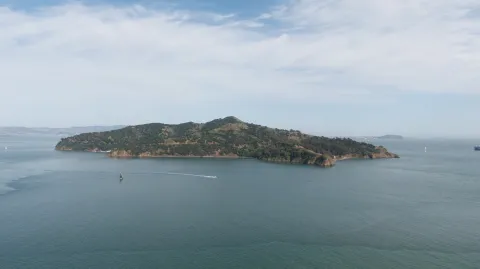
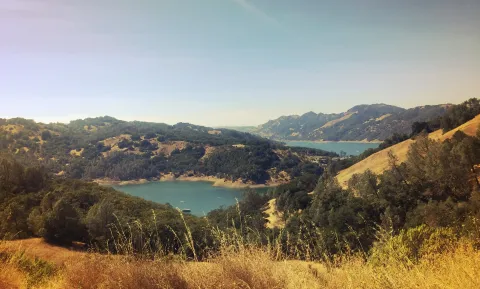
 2.0-4.0 hr stay
2.0-4.0 hr stay
Angel Island State Park ($$)
Angel Island, san francisco
Angel Island State Park, the largest natural island in San Francisco Bay, offers some of the best views of the surrounding Bay Area. Angel Island is a hidden gem in the urban Bay Area, with excellent hiking trails and many other recreational opportunities readily available. From 1910 to 1940, the U.S. Immigration Station (now a museum) processed hundreds of thousands of immigrants, the majority from China.

- 6:00am
- 6:15am
- 6:30am
- 6:45am
- 7:00am
- 7:15am
- 7:30am
- 7:45am
- 8:00am
- 8:15am
- 8:30am
- 8:45am
- 9:00am
- 9:15am
- 9:30am
- 9:45am
- 10:00am
- 10:15am
- 10:30am
- 10:45am
- 11:00am
- 11:15am
- 11:30am
- 11:45am
- 12:00pm
- 12:15pm
- 12:30pm
- 12:45pm
- 1:00pm
- 1:15pm
- 1:30pm
- 1:45pm
- 2:00pm
- 2:15pm
- 2:30pm
- 2:45pm
- 3:00pm
- 3:15pm
- 3:30pm
- 3:45pm
- 4:00pm
- 4:15pm
- 4:30pm
- 4:45pm
- 5:00pm
- 5:15pm
- 5:30pm
- 5:45pm
- 6:00pm
- 6:15pm
- 6:30pm
- 6:45pm
- 7:00pm
- 7:15pm
- 7:30pm
- 7:45pm
- 8:00pm
- 8:15pm
- 8:30pm
- 8:45pm
- 9:00pm
- 9:15pm
- 9:30pm
- 9:45pm
- 10:00pm
- 10:15pm
- 10:30pm
- 10:45pm
- 11:00pm
- 11:15pm
- 11:30pm
- 11:45pm
Eat LUNCH

- 6:00am
- 6:15am
- 6:30am
- 6:45am
- 7:00am
- 7:15am
- 7:30am
- 7:45am
- 8:00am
- 8:15am
- 8:30am
- 8:45am
- 9:00am
- 9:15am
- 9:30am
- 9:45am
- 10:00am
- 10:15am
- 10:30am
- 10:45am
- 11:00am
- 11:15am
- 11:30am
- 11:45am
- 12:00pm
- 12:15pm
- 12:30pm
- 12:45pm
- 1:00pm
- 1:15pm
- 1:30pm
- 1:45pm
- 2:00pm
- 2:15pm
- 2:30pm
- 2:45pm
- 3:00pm
- 3:15pm
- 3:30pm
- 3:45pm
- 4:00pm
- 4:15pm
- 4:30pm
- 4:45pm
- 5:00pm
- 5:15pm
- 5:30pm
- 5:45pm
- 6:00pm
- 6:15pm
- 6:30pm
- 6:45pm
- 7:00pm
- 7:15pm
- 7:30pm
- 7:45pm
- 8:00pm
- 8:15pm
- 8:30pm
- 8:45pm
- 9:00pm
- 9:15pm
- 9:30pm
- 9:45pm
- 10:00pm
- 10:15pm
- 10:30pm
- 10:45pm
- 11:00pm
- 11:15pm
- 11:30pm
- 11:45pm
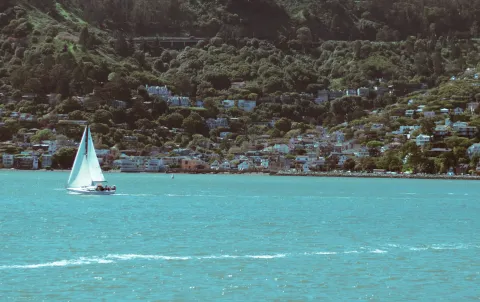
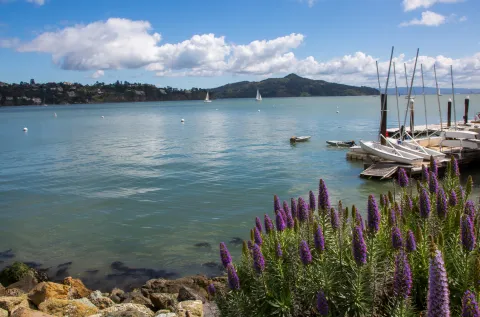
 2.0-4.0 hr stay
2.0-4.0 hr stay
Explore Sausalito (Free Entry)
22 El Portal, sausalito
Sausalito is a picturesque seaside town and a popular tourist destination just a few miles from San Francisco. It was once a fishing village converted into a shipyard during world war II. A bit warmer and sunny compared to San Francisco, with European vacation resort vibes, Sausalito has beautiful boutiques, seafood, art galleries, fancy cafes, gourmet restaurants, a scenic waterfront boardwalk, a marina, houseboats, museums, and much more.

- 6:00am
- 6:15am
- 6:30am
- 6:45am
- 7:00am
- 7:15am
- 7:30am
- 7:45am
- 8:00am
- 8:15am
- 8:30am
- 8:45am
- 9:00am
- 9:15am
- 9:30am
- 9:45am
- 10:00am
- 10:15am
- 10:30am
- 10:45am
- 11:00am
- 11:15am
- 11:30am
- 11:45am
- 12:00pm
- 12:15pm
- 12:30pm
- 12:45pm
- 1:00pm
- 1:15pm
- 1:30pm
- 1:45pm
- 2:00pm
- 2:15pm
- 2:30pm
- 2:45pm
- 3:00pm
- 3:15pm
- 3:30pm
- 3:45pm
- 4:00pm
- 4:15pm
- 4:30pm
- 4:45pm
- 5:00pm
- 5:15pm
- 5:30pm
- 5:45pm
- 6:00pm
- 6:15pm
- 6:30pm
- 6:45pm
- 7:00pm
- 7:15pm
- 7:30pm
- 7:45pm
- 8:00pm
- 8:15pm
- 8:30pm
- 8:45pm
- 9:00pm
- 9:15pm
- 9:30pm
- 9:45pm
- 10:00pm
- 10:15pm
- 10:30pm
- 10:45pm
- 11:00pm
- 11:15pm
- 11:30pm
- 11:45pm
Eat DINNER

- 6:00am
- 6:15am
- 6:30am
- 6:45am
- 7:00am
- 7:15am
- 7:30am
- 7:45am
- 8:00am
- 8:15am
- 8:30am
- 8:45am
- 9:00am
- 9:15am
- 9:30am
- 9:45am
- 10:00am
- 10:15am
- 10:30am
- 10:45am
- 11:00am
- 11:15am
- 11:30am
- 11:45am
- 12:00pm
- 12:15pm
- 12:30pm
- 12:45pm
- 1:00pm
- 1:15pm
- 1:30pm
- 1:45pm
- 2:00pm
- 2:15pm
- 2:30pm
- 2:45pm
- 3:00pm
- 3:15pm
- 3:30pm
- 3:45pm
- 4:00pm
- 4:15pm
- 4:30pm
- 4:45pm
- 5:00pm
- 5:15pm
- 5:30pm
- 5:45pm
- 6:00pm
- 6:15pm
- 6:30pm
- 6:45pm
- 7:00pm
- 7:15pm
- 7:30pm
- 7:45pm
- 8:00pm
- 8:15pm
- 8:30pm
- 8:45pm
- 9:00pm
- 9:15pm
- 9:30pm
- 9:45pm
- 10:00pm
- 10:15pm
- 10:30pm
- 10:45pm
- 11:00pm
- 11:15pm
- 11:30pm
- 11:45pm
Eat BREAKFAST

- 6:00am
- 6:15am
- 6:30am
- 6:45am
- 7:00am
- 7:15am
- 7:30am
- 7:45am
- 8:00am
- 8:15am
- 8:30am
- 8:45am
- 9:00am
- 9:15am
- 9:30am
- 9:45am
- 10:00am
- 10:15am
- 10:30am
- 10:45am
- 11:00am
- 11:15am
- 11:30am
- 11:45am
- 12:00pm
- 12:15pm
- 12:30pm
- 12:45pm
- 1:00pm
- 1:15pm
- 1:30pm
- 1:45pm
- 2:00pm
- 2:15pm
- 2:30pm
- 2:45pm
- 3:00pm
- 3:15pm
- 3:30pm
- 3:45pm
- 4:00pm
- 4:15pm
- 4:30pm
- 4:45pm
- 5:00pm
- 5:15pm
- 5:30pm
- 5:45pm
- 6:00pm
- 6:15pm
- 6:30pm
- 6:45pm
- 7:00pm
- 7:15pm
- 7:30pm
- 7:45pm
- 8:00pm
- 8:15pm
- 8:30pm
- 8:45pm
- 9:00pm
- 9:15pm
- 9:30pm
- 9:45pm
- 10:00pm
- 10:15pm
- 10:30pm
- 10:45pm
- 11:00pm
- 11:15pm
- 11:30pm
- 11:45pm
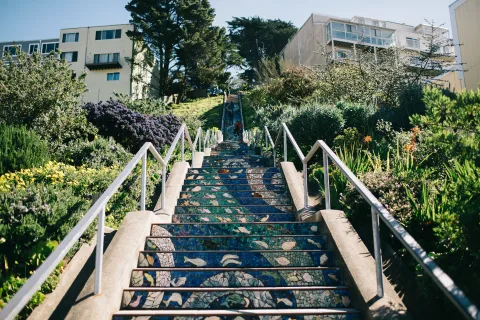
 0.5-1.0 hr stay
0.5-1.0 hr stay
16th Avenue Tiled Steps (Free Entry)
Moraga St & 16th Ave, san francisco
The 16th Avenue Tiled Steps, a hidden gem, is a sea-to-stars-themed mosaic flowing up a 163-step stairway in San Francisco's Golden Gate Heights Neighborhood. The Neighbors sponsored the handmade named tiles in the shapes of animals, fish, and shells within the mosaic for the beautiful stairs.
- 0.9 MILES
- 22 minutes
- Get Directions

- 6:00am
- 6:15am
- 6:30am
- 6:45am
- 7:00am
- 7:15am
- 7:30am
- 7:45am
- 8:00am
- 8:15am
- 8:30am
- 8:45am
- 9:00am
- 9:15am
- 9:30am
- 9:45am
- 10:00am
- 10:15am
- 10:30am
- 10:45am
- 11:00am
- 11:15am
- 11:30am
- 11:45am
- 12:00pm
- 12:15pm
- 12:30pm
- 12:45pm
- 1:00pm
- 1:15pm
- 1:30pm
- 1:45pm
- 2:00pm
- 2:15pm
- 2:30pm
- 2:45pm
- 3:00pm
- 3:15pm
- 3:30pm
- 3:45pm
- 4:00pm
- 4:15pm
- 4:30pm
- 4:45pm
- 5:00pm
- 5:15pm
- 5:30pm
- 5:45pm
- 6:00pm
- 6:15pm
- 6:30pm
- 6:45pm
- 7:00pm
- 7:15pm
- 7:30pm
- 7:45pm
- 8:00pm
- 8:15pm
- 8:30pm
- 8:45pm
- 9:00pm
- 9:15pm
- 9:30pm
- 9:45pm
- 10:00pm
- 10:15pm
- 10:30pm
- 10:45pm
- 11:00pm
- 11:15pm
- 11:30pm
- 11:45pm
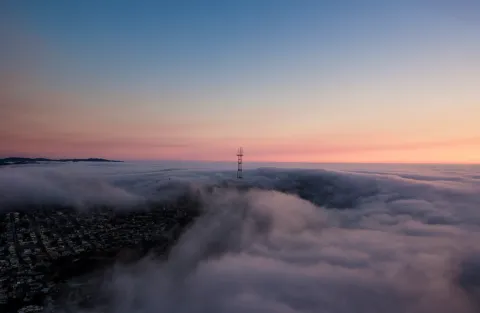
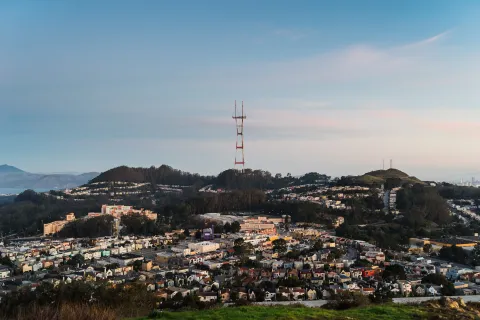
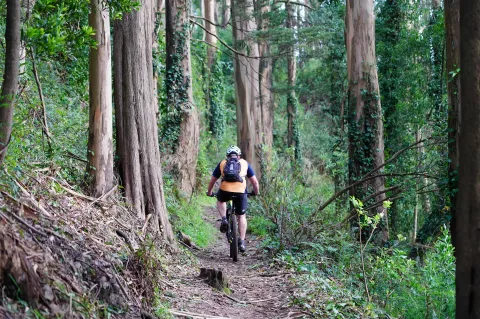
 0.5-1.25 hr stay
0.5-1.25 hr stay
Mount Sutro Cloud Forest (Free Entry)
Mt Sutro, san francisco
An Urban Oasis, Mount Sutro is home to a vibrant, 61-acre open space reserve in the city's center. It is named after San Francisco Mayor (1894-1896) and real estate investor Adolph Sutro. The forest is heavily shaded under the tall Eucalyptus trees and has its own micro-climate. The forest remains cool and wet even when it is hot and dry in the surrounding. Forty-five species of birds, raccoons, skunks, squirrels, skinks, lizards, coyotes, possibly foxes, and other animals call home to this beautiful forest.

- 6:00am
- 6:15am
- 6:30am
- 6:45am
- 7:00am
- 7:15am
- 7:30am
- 7:45am
- 8:00am
- 8:15am
- 8:30am
- 8:45am
- 9:00am
- 9:15am
- 9:30am
- 9:45am
- 10:00am
- 10:15am
- 10:30am
- 10:45am
- 11:00am
- 11:15am
- 11:30am
- 11:45am
- 12:00pm
- 12:15pm
- 12:30pm
- 12:45pm
- 1:00pm
- 1:15pm
- 1:30pm
- 1:45pm
- 2:00pm
- 2:15pm
- 2:30pm
- 2:45pm
- 3:00pm
- 3:15pm
- 3:30pm
- 3:45pm
- 4:00pm
- 4:15pm
- 4:30pm
- 4:45pm
- 5:00pm
- 5:15pm
- 5:30pm
- 5:45pm
- 6:00pm
- 6:15pm
- 6:30pm
- 6:45pm
- 7:00pm
- 7:15pm
- 7:30pm
- 7:45pm
- 8:00pm
- 8:15pm
- 8:30pm
- 8:45pm
- 9:00pm
- 9:15pm
- 9:30pm
- 9:45pm
- 10:00pm
- 10:15pm
- 10:30pm
- 10:45pm
- 11:00pm
- 11:15pm
- 11:30pm
- 11:45pm
Eat LUNCH

- 6:00am
- 6:15am
- 6:30am
- 6:45am
- 7:00am
- 7:15am
- 7:30am
- 7:45am
- 8:00am
- 8:15am
- 8:30am
- 8:45am
- 9:00am
- 9:15am
- 9:30am
- 9:45am
- 10:00am
- 10:15am
- 10:30am
- 10:45am
- 11:00am
- 11:15am
- 11:30am
- 11:45am
- 12:00pm
- 12:15pm
- 12:30pm
- 12:45pm
- 1:00pm
- 1:15pm
- 1:30pm
- 1:45pm
- 2:00pm
- 2:15pm
- 2:30pm
- 2:45pm
- 3:00pm
- 3:15pm
- 3:30pm
- 3:45pm
- 4:00pm
- 4:15pm
- 4:30pm
- 4:45pm
- 5:00pm
- 5:15pm
- 5:30pm
- 5:45pm
- 6:00pm
- 6:15pm
- 6:30pm
- 6:45pm
- 7:00pm
- 7:15pm
- 7:30pm
- 7:45pm
- 8:00pm
- 8:15pm
- 8:30pm
- 8:45pm
- 9:00pm
- 9:15pm
- 9:30pm
- 9:45pm
- 10:00pm
- 10:15pm
- 10:30pm
- 10:45pm
- 11:00pm
- 11:15pm
- 11:30pm
- 11:45pm
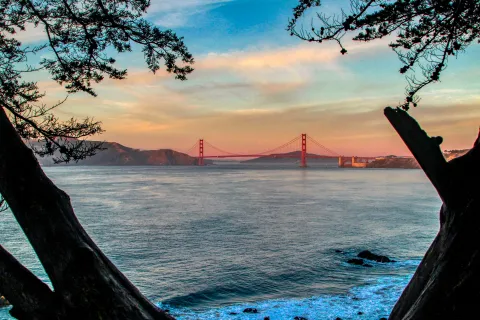



 1.0-1.5 hr stay
1.0-1.5 hr stay
Lands End (Free Entry)
680 Point Lobos Ave, san francisco
Lands End is a wild and windy trail with stunning views at every turn at the northwestern corner of San Francisco. Along the way are hillsides of cypress and wildflowers, views of old shipwrecks, rocky cliffs above the ocean, access to the epic ruins of Sutro Baths in the Sutro Historic District, pocket beaches, spectacular views of the shore, headlands, and Golden Gate, and a new Lookout Visitor Center.
- 0.1 MILES
- 2 minutes
- Get Directions

- 6:00am
- 6:15am
- 6:30am
- 6:45am
- 7:00am
- 7:15am
- 7:30am
- 7:45am
- 8:00am
- 8:15am
- 8:30am
- 8:45am
- 9:00am
- 9:15am
- 9:30am
- 9:45am
- 10:00am
- 10:15am
- 10:30am
- 10:45am
- 11:00am
- 11:15am
- 11:30am
- 11:45am
- 12:00pm
- 12:15pm
- 12:30pm
- 12:45pm
- 1:00pm
- 1:15pm
- 1:30pm
- 1:45pm
- 2:00pm
- 2:15pm
- 2:30pm
- 2:45pm
- 3:00pm
- 3:15pm
- 3:30pm
- 3:45pm
- 4:00pm
- 4:15pm
- 4:30pm
- 4:45pm
- 5:00pm
- 5:15pm
- 5:30pm
- 5:45pm
- 6:00pm
- 6:15pm
- 6:30pm
- 6:45pm
- 7:00pm
- 7:15pm
- 7:30pm
- 7:45pm
- 8:00pm
- 8:15pm
- 8:30pm
- 8:45pm
- 9:00pm
- 9:15pm
- 9:30pm
- 9:45pm
- 10:00pm
- 10:15pm
- 10:30pm
- 10:45pm
- 11:00pm
- 11:15pm
- 11:30pm
- 11:45pm
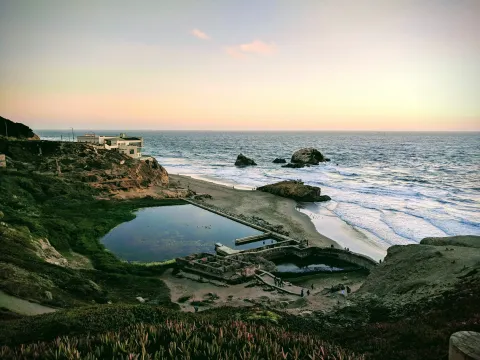



 0.5-1.0 hr stay
0.5-1.0 hr stay
Sutro Baths (Free Entry)
1004 Point Lobos Ave, san francisco
Developed in 1894, Sutro Baths was the largest public indoor swimming pool complex on earth. Adolph Sutro, a wealthy businessman, built this to provide thousands of San Franciscans with a healthy, recreational, and inexpensive swimming facility. The power of the Pacific Ocean during high tide could fill the 1.7 million gallons of water required for all the pools in just one hour. The Baths could accommodate 10,000 people at one time and offered 20,000 bathing suits and 40,000 towels for rent.

- 6:00am
- 6:15am
- 6:30am
- 6:45am
- 7:00am
- 7:15am
- 7:30am
- 7:45am
- 8:00am
- 8:15am
- 8:30am
- 8:45am
- 9:00am
- 9:15am
- 9:30am
- 9:45am
- 10:00am
- 10:15am
- 10:30am
- 10:45am
- 11:00am
- 11:15am
- 11:30am
- 11:45am
- 12:00pm
- 12:15pm
- 12:30pm
- 12:45pm
- 1:00pm
- 1:15pm
- 1:30pm
- 1:45pm
- 2:00pm
- 2:15pm
- 2:30pm
- 2:45pm
- 3:00pm
- 3:15pm
- 3:30pm
- 3:45pm
- 4:00pm
- 4:15pm
- 4:30pm
- 4:45pm
- 5:00pm
- 5:15pm
- 5:30pm
- 5:45pm
- 6:00pm
- 6:15pm
- 6:30pm
- 6:45pm
- 7:00pm
- 7:15pm
- 7:30pm
- 7:45pm
- 8:00pm
- 8:15pm
- 8:30pm
- 8:45pm
- 9:00pm
- 9:15pm
- 9:30pm
- 9:45pm
- 10:00pm
- 10:15pm
- 10:30pm
- 10:45pm
- 11:00pm
- 11:15pm
- 11:30pm
- 11:45pm